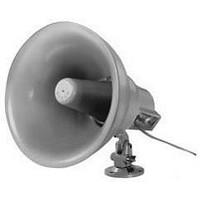AH-5A BOGEN COMMUNICATIONS, AH-5A Datasheet - Page 68

AH-5A
Manufacturer Part Number
AH-5A
Description
Amplified Speaker/horn
Manufacturer
BOGEN COMMUNICATIONS
Datasheet
1.AH-5A.pdf
(88 pages)
Specifications of AH-5A
Peak Reflow Compatible (260 C)
No
Leaded Process Compatible
No
Lead Free Status / RoHS Status
Contains lead / RoHS non-compliant
66
AMPLIFIER INPUT TYPES
Auxiliary Input (AUX)
The Auxiliary input is the most common type of input
used in paging. This input is designed to connect to most
music sources, such as a CD player or tuner. Usually the
connector for such an input is a Phono jack (also called
an RCA jack). It connects to other equipment using stan-
dard audio cables.
The AUX input has an outer connection that is directly con-
nected to the equipment’s ground and a center connec-
tion that is the “hot” input. AUX inputs, sometimes
referred to as Hi-Z or high-impedance inputs, have a high
input impedance so that they won’t put too much of a load
on the source equipment’s output. This type of input is
“unbalanced”. You must use shielded cable with this type
of input in order to avoid getting noise induced into the
system.
Normally, connections between source equipment and the
amplifier’s AUX input should not be too long, about 6 feet.
The problem with long connections is that the cable acts
like an antenna, picking up any electrical noise in the area.
The longer the cable, the more noise that is picked up.
Telephone Input (TEL)
The TEL Input is so named because it was designed to be
compatible with page port outputs of telephone systems.
The TEL input is a 600-ohm transformer-coupled input that:
•
•
•
Bogen’s TEL inputs do not have to be shielded, but it is al-
ways a good idea to provide more noise immunity (nor-
mally a ground terminal is available on the input for the
shield connection). Higher noise immunity allows the am-
plifier to be located much farther away from the source
equipment than what an unbalanced input will allow.
The input transformer is not designed to pass loop current
from a telephone line. Any time you want to connect to a
telephone station or trunk port, you will need to use a tele-
phone interface module like the TAMB, which converts
the telephone signal into a “dry” audio signal compatible
with the amplifier’s TEL input.
proper interfacing
or Key System
noise immunity
matches the impedance of the telephone port to provide
electrically isolates the amplifier from the PBX
provides a balanced input with a great deal of
Telephone Input Screw Terminals
Phono (RCA) Input Jacks
Microphone Input (MIC)
The traditional paging amplifier input is the Microphone
input. MIC inputs were the primary announcement source
until connection to the telephone system became possible.
MIC inputs are still used in public address applications today.
When connected properly, a microphone can be hundreds
of feet away from the amplifier and still provide clear, quiet
audio.
MIC inputs are the most sensitive of all the amplifier in-
puts and tend to pick up the stray electrical noise in an
area. To combat the noise pickup problem, MIC inputs
are balanced. Just like TEL inputs, the balancing of the
input provides a high level of noise immunity. MIC inputs
are also made to have a fairly low input impedance,
which makes it difficult for electrical noise to get in-
duced. The low impedance effectively keeps down noise,
which makes its signal level smaller.
Microphone cable is always shielded. The input requires
three connections – two for the balanced signal and one for
the shield ground. You can reverse the balanced signal
leads and the system will still work properly. However, if you
mis-wire the ground connections, the amplifier can become
unstable and start to oscillate. When this occurs, the am-
plifier may heat up enough to cause its protection
circuits to shut it down or it may produce very distorted
sound.
Balanced Microphone “XLR” Type Connector
Balanced Microphone Screw Terminals
- see page 82












